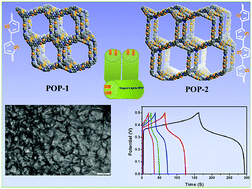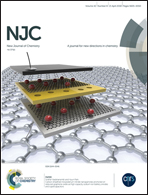Three-dimensional conductive porous organic polymers based on tetrahedral polythiophene for high-performance supercapacitors†
Abstract
Porous organic polymers have become promising electrode materials, but their low surface area and poor electrical conductivity limit their application in high-performance supercapacitors. This study reports the facile synthesis of two porous organic polymers (POP-1 and POP-2) via the condensation of tetra(4-aminophenyl)methane and 2-thenaldehyde or 2,2-bithiophene-5-carboxyaldehyde and their subsequent polymerization. The resulting porous organic polymer materials were characterized using FT-IR, 13C-NMR, X-ray single crystal diffraction, SEM, TEM and N2 adsorption–desorption measurements. This study shows that POP-2 has a diamond topological structure with a regular morphology and a wealth of pores, and a higher BET surface area (342 m2 g−1) when compared with POP-1 (260 m2 g−1). POP-2, when used as an electrode material for supercapacitors, also exhibits a much better electrochemical performance, including higher specific capacitance (332 F g−1) and better cycle stability (capacity retention rate of more than 94% after 10 000 successive cycles). These results verify that the structure and electrochemical properties of porous organic polymer materials can be effectively improved by altering the monomers. This study also provides an approach for building various porous organic polymer materials for use in high-performance supercapacitors.



 Please wait while we load your content...
Please wait while we load your content...